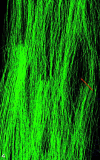MR diffusion tensor imaging and fiber tracking in inflammatory diseases of the spinal cord
- PMID: 17032873
- PMCID: PMC7977871
MR diffusion tensor imaging and fiber tracking in inflammatory diseases of the spinal cord
Abstract
Purpose: Our aim was to study the fractional anisotropy (FA) variations and the fiber tracking (FT) patterns observed in patients with myelitis.
Material and methods: Fifteen patients with symptomatic myelitis and 11 healthy subjects were prospectively selected. We performed T2-weighted and diffusion tensor imaging on a 1.5T MR scanner. FA and apparent diffusion coefficient maps were computed in both healthy subjects and patients. In each patient, we performed FT to study pathologic aspects on this imaging method. FA data were analyzed by using z-scores.
Results: For the healthy subjects, averaged FA values ranged from 0.745 to 0.751. All abnormal areas seen on T2-weighted imaging had a significantly decreased FA value. In 9 patients (60%), FA maps showed decreased FA areas, whereas T2-weighted imaging findings were normal. These areas matched the neurologic deficit in 33%. Eighty percent of patients had multiple decreased FA areas. Five patients (33%) had increased FA values in normal T2-weighted areas.
Conclusion: We observed specific FA and FT pattern variations in patients with myelitis.
Figures





Comment in
-
Comparison between diffusion tensor imaging and conventional MR imaging sequences in the detection of spinal cord abnormalities.AJNR Am J Neuroradiol. 2007 May;28(5):806-7. AJNR Am J Neuroradiol. 2007. PMID: 17571452 Free PMC article. No abstract available.
References
-
- Spitzer C, Krings T, Block F. Inflammatory diseases of the spinal cord. Radiologe 2001;41:968–75 - PubMed
-
- Scotti G, Gerevini S. Diagnosis and differential diagnosis of acute transverse myelopathy: the role of neuroradiological investigations and review of the literature. Neurol Sci 2001;22(suppl 2):S69–73 - PubMed
-
- Jones DK, Griffin LD, Alexander DC, et al. Spatial normalization and averaging of diffusion tensor MRI data sets. Neuroimage 2002;17:592–617 - PubMed
MeSH terms
LinkOut - more resources
Full Text Sources
Other Literature Sources
